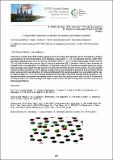Por favor, use este identificador para citar o enlazar a este item:
http://hdl.handle.net/10261/210925COMPARTIR / EXPORTAR:
 SHARE
BASE SHARE
BASE
|
|
| Visualizar otros formatos: MARC | Dublin Core | RDF | ORE | MODS | METS | DIDL | DATACITE | |

| Campo DC | Valor | Lengua/Idioma |
|---|---|---|
| dc.contributor.author | Campos-Martínez, José | - |
| dc.contributor.author | Hernández, Marta I. | - |
| dc.contributor.author | Hernández-Lamoneda, Ramón | - |
| dc.contributor.author | Bartolomei, Massimiliano | - |
| dc.date.accessioned | 2020-05-10T11:19:22Z | - |
| dc.date.available | 2020-05-10T11:19:22Z | - |
| dc.date.issued | 2019-07-15 | - |
| dc.identifier.citation | XXXVII Reunión Bienal de la Real Sociedad Española de Física (2019) | - |
| dc.identifier.uri | http://hdl.handle.net/10261/210925 | - |
| dc.description | Zaragoza, 15 -19 de julio de 2019 | - |
| dc.description.abstract | It has been recently found that pristine graphene and some other 2D materials can be permeated by protons and deuterium at room temperature [1,2], following a low barrier (~ 0.8 eV) activated process. Most of the theoretical attempts have found so far, that permeation of the H+ (D+) involves large energy barriers (around 3.5 eV) and therefore they are too high to explain experiments [3]. In previous models it was assumed an isolated proton permeating the 2D membrane. In this work however, we consider protonated graphene at high local coverage and explore the role played by nearby chemisorbed protons in the process. By using density functional theory calculations (DFT) applied to large molecular prototypes for graphene we have found [4] that when various protons are absorbed on carbons belonging to the same hexagonal ring, permeation barrier can be lowered down to 1.0 eV, thus making feasible the permeation of protons through pristine graphene. The proposed insertion mechanism necessarily need to count with the nearby protons and it could be of relevance not only to help in the understanding of the experimental results, but also in many other scenarios of basic and technological interest. References [1] S. Hu, M. Lozada-Hidalgo, F. C. Wang, A. Mishchenko, F. Schedin, R. R. Nair, E. W. Hill,D. W. Boukhvalov, M. I. Katsnelson, R. A. W. Dryfe, et al., Nature 516, 227 (2014). [2] M. Lozada-Hidalgo, S. Hu, O. Marshall, A. Mishchenko, A. N. Grigorenko, R. A. W. Dryfe,B. Radha, I. V. Grigorieva, and A. K. Geim, Science 351, 68 (2016). [3] Kroes et al., Phys. Chem. Chem. Phys. 19, 5813 (2017), Ekayanake et al. J. Phys.Chem C, 1231, 24335 (2017), Shi et al. J. Phys. Chem. Letts. 8, 4354 (2017), Feng et atl, J. Phys.Chem. Lett., 8 , 6009 (2017), Poltavsky et al. J. Chem. Phys., 148, 204707 (2018), Mazzuca et al, J. Chem. Phys., 148, 224301 (2018). [4] M. Bartolomei, M. I. Hernández, J. Campos-Martínez, R. Hernández-Lamoneda, Carbon, 144, 724-730 (2019). | - |
| dc.language | eng | - |
| dc.publisher | Real Sociedad Española de Física | - |
| dc.rights | openAccess | - |
| dc.title | A multi-proton cooperative mechanism for graphene permeation of protons | - |
| dc.type | póster de congreso | - |
| dc.date.updated | 2020-05-10T11:19:22Z | - |
| dc.relation.csic | Sí | - |
| dc.type.coar | http://purl.org/coar/resource_type/c_6670 | es_ES |
| item.fulltext | With Fulltext | - |
| item.grantfulltext | open | - |
| item.cerifentitytype | Publications | - |
| item.openairetype | póster de congreso | - |
| item.openairecristype | http://purl.org/coar/resource_type/c_18cf | - |
| Aparece en las colecciones: | (CFMAC-IFF) Comunicaciones congresos | |
Ficheros en este ítem:
| Fichero | Descripción | Tamaño | Formato | |
|---|---|---|---|---|
| A multi-proton cooperative.pdf | 228,33 kB | Adobe PDF |  Visualizar/Abrir |
CORE Recommender
Page view(s)
138
checked on 22-abr-2024
Download(s)
58
checked on 22-abr-2024
Google ScholarTM
Check
NOTA: Los ítems de Digital.CSIC están protegidos por copyright, con todos los derechos reservados, a menos que se indique lo contrario.
